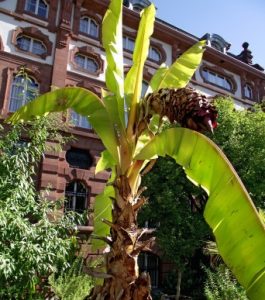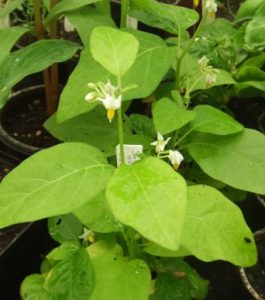 Common Name: Enset
Common Name: Enset
Description
Ensete ventricosum, commonly known as the Ethiopian banana, Abyssinian banana, false banana, or ensete, is an herbaceous species of flowering plant in the banana family Musaceae. The name Ensete ventricosum was first published in 1948 in the Kew Bulletin, 1947, p. 101. Its synonyms include Musa arnoldiana De Wild., Musa ventricosa Welw. and Musa ensete J.F.Gmel. It is native to the eastern edge of the Great African Plateau, extending northwards from the Transvaal through Mozambique, Zimbabwe, Malawi, Kenya, Uganda and Tanzania to Ethiopia, and west to the Congo, being found in high rainfall forests on mountains, and along forested ravines and streams. . . . .Read more
References
Switchboard
Wikipedia
Annuals
Vigna radiata
 Common Name: Mungbean
Common Name: Mungbean
Description
The mung bean (Vigna radiata), alternatively known as the moong bean, green gram, is a plant species in the legume family. The mung bean is mainly cultivated in India, China, and Southeast Asia. It is used as an ingredient in both savory and sweet dishes. . . . .Read more
References
Switchboard
Wikipedia
Solanum aethiopicum
 Common Name: African Eggplant
Common Name: African Eggplant
Description
Solanum aethiopicum, the bitter tomato, Ethiopian eggplant , or nakati, is a fruiting plant of the genus Solanum mainly found in Asia and Tropical Africa. It is also known as Ethiopian nightshade, garden eggs, and mock tomato. It is a popular vegetable in north-east India, and is known as khamen akhaba in Manipuri and samtawk in Mizo. These names are a result of its varied morphology, with ripe fruit often looking like a cross between an eggplant and a tomato, which are also from Solanum. In fact, the Ethiopian eggplant was so much confused with the ordinary eggplant that t . . . . .Read more
References
Switchboard
Wikipedia
Lablab purpureus
 Common Name: Lab lab Bean
Common Name: Lab lab Bean
Description
Lablab purpureus is a species of bean in the family Fabaceae. It is native to Africa and it is cultivated throughout the tropics for food. English language common names include hyacinthbean, lablab-bean bonavist bean/pea, dolichos bean, seim bean, lablab bean, Egyptian kidney bean, Indian bean, bataw and Australian pea. It is the only species in the monotyp. . . . .Read more
References
Switchboard
Wikipedia